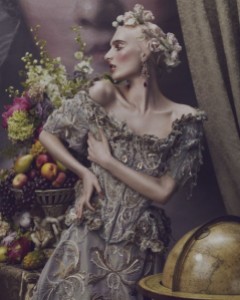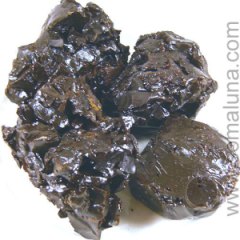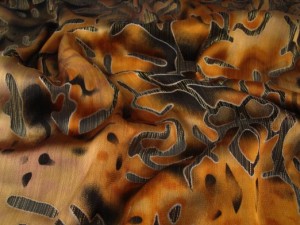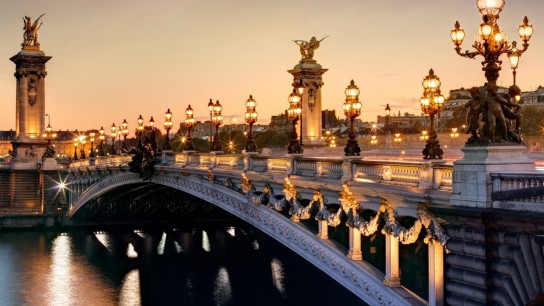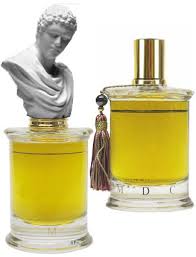Let’s take a look at IFRA/EU restrictions on oakmoss, the future of chypres, the reasons why fragrance houses are eschewing chypres, fractional distillation to remove IFRA-forbidden allergens, the use of seaweed to supplement or create an oakmoss base, the type of oakmoss that suppliers make available to perfume houses, and how the fear of still more restrictions in the future is impacting the types of scents that perfume houses are making. A fascinating, highly informative discussion of these issues took place last night on Twitter with several experts chiming in to explain what is going on behind the scenes and its significance. I learnt a considerable amount, particularly regarding the type of oakmoss currently on the market, and I’d like to share that with you here.
Tag Archives: Chypre Fragrances
LM Parfums Army of Lovers
Opulent roses and animalic leather lie at the heart of Army of Lovers, the latest release from LM Parfums. Although it is ostensibly a chypre, Army of Lovers often feels more like a leather fragrance than one redolent of oakmoss. The greenness shimmers like a distant mirage, whilst all before you is musky leather that has been smeared with honey, sprinkled with spices, then nestled amongst some jammy roses in a stable. There is no getting around that last part, as this is one very dirty, raunchy leather that has a definite equine vibe for a good portion of its lifespan on my skin.
In fact, Army of Lovers often reminded me of the old story about Camilla Parker-Bowles, now Duchess of Cornwall, who would allegedly go straight from riding her horse after a long day at the hunt to slipping on an expensive evening gown and attending a party, without a shower in-between. Yet, something about that shimmering oakmoss mirage in the background makes Army of Lovers more than dirty, horse-y leather wrapped up with rubied roses. LM Parfums’ founder, Laurent Mazzone, once told me that he loves the great vintage legends like Mitsouko, and that he seeks to bring the same sort of vibe to his fragrances, only in a more modern way.

Movie poster for Lady Chatterley’s Lover (1981 version) with Sylvia Krystel. Source: movies.film-cine.com
That sort of old-school sophistication hovers around Army of Lovers in a way that makes the Camilla Parker-Bowles story seem more apt for the characters of Downton Abbey, or some mash-up of a Ralph Lauren ad involving British aristocrats, riding, and evening gowns. There is a twist, though: these aristocrats are plucked from D.H. Lawrence‘s Lady Chatterley’s Lover and end up having a rather raunchy frolic with a musky, dirty gamekeeper in the stables.
Let’s start at the beginning. Army of Lovers is part of LM Parfums‘ Intimacy Collection, a stronger, more expensive range which is centered around pure parfums made from more luxurious ingredients. Hard Leather was the first in the collection, and Army of Lovers joined it on October 15th, with an official launch date of November 1st.
Upcoming New Release: LM Parfums Army of Lovers
LM Parfums will be releasing its newest fragrance soon. Army of Lovers is a chypre that I really loved when I had the opportunity to try it last year. I don’t usually post about upcoming releases, but thought I would make an exception for this one.
Army of Lovers is part of The Intimacy Collection, which is a stronger, more expensive range within the LM Parfums line centered around pure parfums with more luxurious ingredients. Hard Leather was the first in the collection, and Army of Lovers will be joining it on October 15th with an official launch date of November 1st.
Parfums MDCI Chypre Palatin: Baroque Grandeur

One small part of Blenheim Palace, England. Photo: WillowbrookPark.Blogspot.com (Website link embedded within.)
Somewhere in an alternate universe, there must surely be a European palace that smells of Chypre Palatin. The massive, stony Neo-Classical structure opens onto a vast entrance hall decorated with mossy, emerald velvet and gold in an opulently ornate Baroque and Rococo style. An enormous chandelier hangs from the vaulted ceilings painted in citrus yellow, ambered gold, delicately pastel florals, and more mossy greens. Light sparkles off the prisms, bouncing into ambered air filled with just a trace of incense.
The vast hall gives way to a long, mirrored passage way filled with dancing ghosts called Shalimar, Bal à Versailles, Sacrebleu Intense, Coromandel, Habit Rouge. and Yvresse/Champagne. They blow you scented kisses, and the aroma melts into the citrus and mosses that waft off the velvet covering the walls, mixing with the vanilla that seeps up from the floors. The Bal à Versailles ghost is particularly naughty, flashing you her knickers and a glimpse of her musky, naked breasts. It seems as though you’re in that ornate passageway forever, but after a few hours you enter the heart of the house. The royal bedchambers are decorated with more velvet, this time in shades of resinous black, vanilla custard cream, golden amber, and refined patchouli brown. There, you curl up to sleep, covered in aromas like the finest, sheerest, but richest, silks that glide over you in a whisper of softened, ambered sweetness. That is the palace of Chypre Palatin.

Drottningholm Palace, Sweden. Photo: CubeFarmEscape at http://cubefarmescape.com/2011/06/pick-a-palace-or-two/
Chypre Palatin is an eau de parfum created by the famous Bertrand Duchaufour for Parfums MDCI. The French niche house was founded in 2003 by Claude Marchal with a specific philosophy: that perfumes “should be an art more than an industry, a source of pleasure, pride and beauty more than a commodity.” Mr. Marchal was inspired by the luxurious opulence of the Renaissance, and the masterpieces that came out of it: the palaces of Catherine de Medici; the lush gardens of the Luxembourg; Greek and Roman antiquities; gold and rock-crystal vases; the vast treasures of Louis XIV, the Sun King, or those found in Florence’s Uffizi museum and Vienna’s Treasure Room.
Parfums MDCI decided to ask the world’s most famous perfumers to make a small number of fragrances with almost total freedom, and a no-holds-barred, unlimited budget. There were only two caveats: use the most expensive, richest ingredients possible; and don’t create scents that copy trends or caters to the crowd. The cost didn’t matter, but excellence did, no matter how long it took. Parfums MDCI is not one of those houses that puts out several fragrances at year, let alone several collections every few months. (Tom Ford, I’m glaring straight at you.) In fact, Parfums MDCI had only 5 fragrances in their line at first, but the number has slowly risen over the years to include 8 more scents. Chypre Palatin was released in 2012 and, as noted earlier, was made by Bertrand Duchaufour.
First in Fragrance has what looks like the official press release description for Chypre Palatin, as well as the most complete set of notes that I’ve found. I think the description is accurate to large degree, so I’ll quote it in full, even though it is quite long:
The opening is green, a warm, woody and strong green, peppered with a few hyacinths, garnished with the fragrant ripe flesh of clementines, spiced with a sprig of lavender and a hint of thyme. All this creates cozy, warm frissons, intrigues and generates a great appetite for more.
The skilled use of aldehydes lets Chypre Palatin shine, but without getting into too-familiar waters. We can already imagine the soft growl of a wild cat. She lolls pleasurably, full of devotion and delight on the sun-warmed forest floor, crushing the dark velvety roses, iris, gardenia and jasmine. It is so mysterious that our senses are in turmoil. Here and there, dried fruit and peppery Oriental spices join this lascivious game of the lioness as her birth-giving becomes more enticing and the fire blazes.
Here is masculine animality and feminine lust perfectly united and masterfully enacted. It is an indulgence and a stroll in brocade and velvet, courted by the most beautiful leather and the delicate touch of Immortelle. Balsam of Tolu and vanilla show themselves along with the extreme complexity of benzoin and storax that perfectly harmonize with typical chypre oak moss.
Chypre Palatine seems to have fallen directly through time where nostalgic, magnificent ball-nights combine with wild cat-like grace and flirt with the melting of feminine and masculine fragrant notes on the skin.
Top Note: Hyacinth, Clementine, Aldehydes, Labdanum (Rockrose), Galbanum, Thyme, Lavender
Heart Note: Rose, Jasmine, Iris, Prune, Gardenia
Base Note: Benzoin, Storax, Leather, Vanilla, Balsam of Tolu, Castoreum, Costus, Oakmoss, Everlasting Flower [Immortelle].
Chypre Palatin opens on my skin with mossy sharpness infused with bright, sun-sweetened tangerines, zesty lemon, and tons of smoky sweetness from the styrax resin, along with a hint of its leathered underpinnings. In the base, there is a rich plumminess mixed with incense and leather. A quiet floracy weaves through the top notes, though it’s impossible at this point to tease them out. Seconds later, the castoreum and animalic costus root arrive. Costus root is something that gave vintage Kouros is urinous growl, but here, it add a civet-like muskiness that is perfectly balanced. Sharp and definitely a bit skanky, but never urinous. It’s damn sexy. My God, is this a sexy perfume.
Completing the picture are sparkling aldehydes, and the dark, green pungency of galbanum. Now, I normally struggle with both notes, as galbanum can be painfully sharp in its green-blackness, while aldehydes often turn to pure soap on my skin. Not here. Not with Chypre Palatin. They are so perfectly calibrated, I can’t get over it.
The aldehydes combine with the utterly spectacular, velvety, rich oakmoss (how can this perfume be IFRA compliant???!) to conjure up the fizzy, sparkling elegance of YSL’s gorgeous fruity chypre, Champagne or Yvresse. The galbanum somehow manages to evoke the famous Bandit from Robert Piguet, only in approachable, less dangerous or brutal form. There is something of Bandit’s green leathered feel lurking about that normally difficult note, but it’s just the faintest suggestion and somehow serves to amplify the overall depth of the oakmoss. The latter never feels fusty, dusty, or like grey mineralized lichen, but it’s not the bright, fresh, springy moss note generated by patchouli, either. On my skin, it smells like really expensive oakmoss — and a lot of it. I really have no idea how this perfume passed IFRA/EU compliance tests. Whatever combination of elements or tricks Bertrand Duchaufour used to create this vision of endless, forest-green velvet, it really feels genuine.
The overall effect of the avalanche of notes that falls over me is not just the impression of incredibly baroque grandeur, but a flashback to the past. Chypre Palatin feels like a greatest hits remix of: Bandit, Shalimar, Habit Rouge, Champagne/Yvresse, Coromandel, and vintage Bal à Versailles. I’m not complaining. Not one bit. In fact, I gulped at the opening, said “Oh my God,” promptly dabbed on some more, and then felt like one of those possessed figures you see in horror movies whose head spins around and around. Only here, I was joyously possessed by such incredibly opulence, such intense deepness, and sensual headiness in such a seamless, luxurious blend that I didn’t know what to take in first.
Yet, Chypre Palatin is more than various parts of its ghostly, perfume predecessors, and is quite its own thing. Yes, it is retro and classique; the fougère elements, the aldehydes, galbanum, oakmoss, and skanky touches all harken to the past. However, it also feels modern with the definite oriental foundation. This isn’t a Chypre to me, not even at first, but a Chypre-Oriental hybrid done with a lightness that belies the heaviness of its super-rich notes. Perhaps the most modern aspect of Chypre Palatin for me is that careful calibration that I talked about earlier. There is none of the excess of the past, whether it is vintage Bal à Versailles’ hardcore, dirty, skank, Bandit’s brutal bite, or the tidal waves of aldehydes in any number of classics from the 1920s Chanel No. 5 to the 1970s Van Cleef & Arpels‘ First. Everything here is measured, to the point of being super refined, even muffled to an extent. Perhaps that is why I keep envisioning extremely thick, forest green, velvet curtains around a four-poster bed, drowning out the sound.
Yet, there are dainty touches that subtly waft around the baroque splendour. Delicate hyacinth adds a floral pastel colour to the opulent decor, while the iris brings in a touch of sweet, powdered suede. Initially, I don’t detect the lavender in any concrete, individual way, but after ten minutes, a definite strain of something herbal creeps in. It’s not the revolting, pungent, almost abrasive dried sort that evokes barber shops or something medicinal. Instead, it’s creamy, slowly turning into lavender-vanilla icecream. Tiny pops of bright colour come from the yellow citruses, while the orange tangerine brings in a dash of sweetness.
Chypre Palatin sometimes feels more like a seamless movement of notes, a piece of richly elaborate music, or a mood than a set of distinct notes. It rolls over you like a plush, seamless mix that is simultaneously mossy, fresh, dark, bright, animalic, fruity, leathered, smoky, resinous, vanillic, skanky, and sparkling. It overwhelms my senses, in the best way possible. Coincidentally, around the time that I sat down to do a full, proper test of Chypre Palatin, I put in a DVD of Carmen, the opera from Bizet. (No, I swear, contrary to what it may seem like these days, I don’t listen only to opera! My favorite groups are actually Rammstein and Depeche Mode, and I also tend to listen to a lot of ’80s music.) In any event, Carmen’s overture is pretty famous, one of those things that many people will recognise once they hear it, and I’ll be damned if the movement of the music didn’t feel exactly like the movement of Chypre Palatin in the first hour.
So, the best way I can convey to you how Chypre Palatin’s opening feels like to me is to share with you this short, 2 minute clip of Carmen’s overture. Take note of the rapidity of the musicians’ movements, their enormous precision, the music’s moments of daintiness, the occasional bursts of something darker from the drums, and how seamlessly everything fits together. They manage to create a mix that has sparkling vibrancy, symphonic complexity and opulent intensity. For me, it’s not only catchy but representative of Chypre Palatin’s initial deluge of notes:
It’s hard to decide what is my favorite part of the scent’s opening phase. At first, my favorite part of Chypre Palatin is the skank naughtiness that lurks in the base. It strongly evokes Bal à Versailles, but MDCI’s version lacks the powderiness and extreme dirtiness of the famous legend. Ten minutes later, like the most fickle person imaginable, I decide the real beauty is not the faintly raunchy take on oakmoss, but the way the fruits are so beautifully nestled into the dark styrax. Out of all the resins, that is the one which is the least sweet, the most smoky and leathered. Then again, the growing flickers of labdanum is gorgeous, as is the subtle patchouli. They show up after 20 minutes, with the labdanum giving a quiet touch of nutty toffee in the base.
On the other hand, Tolu Balsam is my second favorite resin (after Peru Balsam), and it adds a rich, opulent, treacly layer to the base. It is faintly spiced with what feels like cinnamon, but it is also infused with a growing sense of vanilla. Something about the overall combination of the citrus-flecked oakmoss on top, with the smoky, leathered, animalic, resinous and vanillic accords at the bottom, keeps bringing vintage Shalimar to mind, as well as Shalimar’s cologne counterpart, Habit Rouge, and Shalimar’s descendant, Parfums de Nicolai‘s Sacrebleu Intense. Shalimar has Peru Balsam (a brother to the Tolu kind in Chypre Palatin), along with citruses, vanilla, civet, rose, jasmine, orris, and leathered, smoky touches. Those notes are either the same as, or one tiny degree apart from, the notes in Chypre Palatin. It’s the same story with Habit Rouge, though I think that has Chypre Palatin’s styrax instead of either Tolu or Peru Balsam. In contrast, Sacrebleu Intense is more overtly floral but also shares fruits, vanilla, cinnamon, smoke, patchouli and the same tolu balsam base.
There are obvious differences, however, primarily the heady and hefty amounts of greenness in Chypre Palatin. For the first few hours, that is the dominant colour of the scent, mostly from the oakmoss but also from small strains of the galbanum and patchouli. The oakmoss is thoroughly lemony and slightly fruity, though the latter is never strongly sweet. The herbal and lavender accord fades away extremely quickly on my skin, thereby ensuring that Chypre Palatin never ventures into cologne or barbershop territory.
It’s very hard to deconstruct Chypre Palatin because it is a prismatic scent. By that, I mean that the perfume throw off different notes like light hitting crystals on a chandelier, with each wearing revealing different facets at different times. Part of it, again, is how beautifully Bertrand Duchaufour has blended the fragrance, as well as the obviously expensive, high-quality of the ingredients. Chypre Palatin doesn’t change dramatically in its core essence for the next few hours, but different notes feel highlighted at different times. Sometimes, it is the vanilla; at other times, the skank, the leather, citruses or resins take turns. At all times for the first 4 hours, those notes radiate out from the green-velvet oakmoss core. The weakest elements on my skin are the hyacinth, lavender, orange, iris and jasmine. In fact, the overall floral accord is the hardest to tease out into individual notes. The jasmine might be the most noticeable one, but, as a whole, you merely have the sense of a truly lush, velvety, oakmoss-infused “floral bouquet.”
The more obvious change to Chypre Palatin over time is not the development of a particular note, but the perfume’s sillage and weight. At first, it wafted out about 3 inches from the skin. The overall bouquet feels much thicker and heavier than it actually is, since the perfume itself is quite airy in weight. Chypre Palatin is so potent up close, that it feels opaque, concentrated and ornate. That is deceptive and fools you into not realising how the projection is slowly dropping, but it’s hard to miss after 45 minutes. Chypre Palatin turns thinner, lighter, and less rich in weight. It also becomes very soft and discreet in projection, wafting an inch above the skin by the end of the first hour.
90 minutes in, Chypre Palatin is a blur of vanilla, citruses and oakmoss, trailed by incense, dark resins, and a subtle, muted touch of very abstract florals. Unfortunately, you have to sniff hard to detect all the layers and details because, from afar, Chypre Palatin seems primarily like a vanilla-oakmoss scent with some citruses. The vanilla is lovely, though. Smooth, deep, air-whipped, and with only a dash of sweetness. It’s too gauzy to feel like custard, but there is a wonderful eggy richness to it.
Still, everything else seems to have collapsed on each other like a house of cards blowing over. It’s partially the fault of how well-blended and seamless the fragrance is; all the secondary notes have melted into each other. Only the prism’s core — that triptych of oakmoss, vanilla, and vaguely citrusy fruits — really stands out easily. I just wish it hadn’t happened so soon, especially as Chypre Palatin feels as though it’s about to turn into a skin scent any moment now. It doesn’t, but it’s a frustrating feeling that continuously plagues me. In reality, Chypre Palatin tenaciously hovers just above the skin for several more hours, and doesn’t turn into actual skin scent until the 5.5 hour mark. I’m constantly taken aback by how rich it is up close. The weak sillage is very misleading.
The more immediate change is that the scent turns more and more vanillic. By the start of the 3rd hour, when I smell Chypre Palatin from afar, I primarily get a blur of sweet, rich vanilla that sits atop a layer of vaguely spicy, smoky, dark resin. The fruited-oakmoss duo occasionally joins the vanilla, but, more and more, it lurks in the background.
With every passing hour, the resins move closer and closer to the surface. By the start of the 5th hour, Chypre Palatin is halfway transformed into an amber scent dominated by toffee’d, caramel labdanum. There are strong veins of smoke, Tolu balsam, vanilla, and lightly spiced, brown-red, woody patchouli, all blended within the amber’s golden-brown folds. But every time I think the oakmoss-citrus accord has finally vanished, it somehow pops back up. On two occasions, I briefly thought that Chypre Palatin had reverted back to being a vanilla-oakmoss fragrance, only for the amber to push the duo back and take the lead again. The overall effect is a beautiful, concentrated richness that belies Chypre Palatin’s sheerness.
New elements arrive to weave their way through the amber. There is a really subtle, muted hint of booziness that lurks about Chypre Palatin’s edges, no doubt thanks to the patchouli in combination with the labdanum. There is also a lovely cinnamon that is sprinkled over the vanilla. Much of this is due to the Tolu balsam. According to Fragrantica and other sites, Tolu balsam has a deeply velvety richness with a vanilla aroma that is much darker than that of benzoins. To my nose, however, it is always a very spiced, slightly smoky, rather treacly, dark note with a subtle leathered nuance; it doesn’t feel like a truly vanillic element. To give you an idea of what I’m talking about, here are a some of the perfumes listed by Fragrantica as scents that feature Tolu balsam (or its close sibling, Peru balsam, in some cases): Bal à Versailles, Opium Ormonde Jayne’s Tolu, Estee Lauder‘s Youth Dew and Cinnabar, MPG’s Ambre Precieux, Mona di Orio‘s Ambre, Guerlain‘s Chamade, Rance‘s Laeticia, Memo‘s Italian Leather, Reminiscence‘s Patchouli Elixir, and many others.
If I’m spending more time talking about all these ambered or dark elements than the florals that technically make up a “chypre” fragrance, it’s simply because Chypre Palatin isn’t really a floral scent on my skin. It was muted and largely abstract at the start, and it soon becomes the last horse in the race. By the start of the 3rd hour, I’m not sure it’s even there any more. It certainly isn’t by the time Chypre Palatin enters into its heart phase which is dominated by the aforementioned tolu balsam, then labdanum, vanilla and refined patchouli.
And what patchouli it is too! Beautifully red-brown, slightly spicy, and wafting tendrils of incense-like smokiness. Like the Tolu balsam, it has a subtle nuance of something leathered, but there is nothing earthy, green, minty or “head-shop”-like about this note. Actually, the overall combination strongly — strongly — conjures up Chanel’s glorious Coromandel for me. It has to be the way the patchouli is simultaneously vanillic and smoky. The only difference here is that Chypre Palatin feels significantly darker. There is white chocolate or visuals of chai lattes. Also, there remains the faintest hint of skankiness that occasionally waves its musky arm at you from the edges.
For hour after beautiful hour, Chypre Palatin radiates a plethora of brown, golden, umbered, and ambered hues. The notes are perfectly balanced between dryness, sweetness, and darkness. Somehow, to my utter confusion, Chypre Palatin almost seems to have increased in projection, or perhaps the resinous balsams are simply so rich that they’re throwing out little tendrils in the air. I could have sworn it had turned into a skin scent but, when the wind blew as I took the Hairy German out for a walk around the 10th hour, I could feel the flickers of Chypre Palatin’s incense-patchouli-balsam notes lightly swirling around me. Chypre Palatin remains that way until its very end when it fades away in a blur of abstract, dry sweetness. All in all, 3 medium-ish dabs gave me 14.75 hours in duration. I’m astonished, especially given my wonky skin. It really is a testament to the richness of the notes in question. No expense spared, indeed!
In case it wasn’t obvious by now, I’m rather in love with Chypre Palatin. If the perfume were the imperial official that the “Palatin” part of its name references, I would ask him to… well, never mind. Just trust me when I say that… No, on second thought, really, never mind. All I’ll say is that I wasn’t alone in having an intensely strong reaction to the fragrance. I made The Perfume Snob #1 try it, primarily because my sophisticated, haughty mother has loved and wore every opulent, over-the-top, oriental, chypre and/or skanky classic ever made, from vintage Bal à Versailles to Joy, Opium, Femme, Jolie Madame, and many others.
However, she’s extremely hard to please with modern scents, unless it’s an Amouage. Otherwise, whenever I’ve approached her lately at the weekend dinners, wafting some new scent that I’ve been testing, she’s given me a definite “don’t even think about it” look. (One scent that I shan’t name resulted in an ultimatum that I leave the house if I didn’t scrub it off immediately.) Many of my favorites from Fille en Aiguilles to Fourreau Noir, De Profundis, and Ambra Aurea trigger a dismissive Gallic shrug, while the glorious Mitzah resulted in a violent shudder. Perfume Snob #1 is often impossible to please, but she took one sniff of Chypre Palatin, clutched her wrist, and went glassy-eyed. She then spent the rest of the time until I left sniffing her wrist compulsively and, by her reserved standards, raving about it. I’m still blinking thinking about the intensity of her reaction.
For The Scented Hound, Chypre Palatin also “struck a nerve upon first sniff[.]” My sample was a gift from him, and he clearly has phenomenal taste. However, his experience was very different from mine, and shows another side to this very prismatic scent. In his review, he writes, in part:
Chypre Palatin’s first offered up a rush of citrus and cedar and then quickly a warm amberish lavender and what seemed to be eucalyptus (but I’m not seeing eucalyptus in the notes?? hmmm). The fragrance goes on very warm without being heavy and it’s very comforting. In a little while the scent then moves to an even warmer almost floral setting. It’s very peaceful and serene. The kind of scent where you want to close your eyes and breath in its aromatherapeutic qualities.
As Chypre Palatin continues it’s drydown it moves into a very familiar what I would call barbershop phase. It’s traditional and old world and masculine at this point. But stop, don’t let me confuse you by thinking this fragrance is old-fashioned and masculine. It’s not. The opening and the dry down make it much more universal and modern. In the end, Chypre Palatin quiets down to a nice oak moss and vanilla scent with just a touch of powder. However, depending on what you’re doing, those middle warm aromatic notes will still come to surface as the day wears on.
Longevity is average as is the sillage. Chypre Palatin is a lovely surprise that feels old and new world at the same time and I think would be perfect for men and women alike.
For Suzanne of Eiderdown Press, Chypre Palatin wasn’t masculine but more akin to Amouage’s Jubilation 25 (Women), and a scent that swept her off her feet by bottling the majestic grandeur of Paris. She writes, in part:
This is one of the richest smelling chypres I’ve ever worn; to the degree that I’m not sure I would have identified it either as a chypre or as something created by perfumer Bertrand Duchaufour if I had smelled it blind without knowing its name or maker. […] Chypre Palatin smells stately, grand and what I think of as classically French in terms of its construction … and maybe because it is a Duchaufour creation, it doesn’t go overboard in this direction. It’s got just enough heft and richness to suggest opulence without crossing over into ostentation.
Before I describe it further, let me say that while it’s marketed as a masculine, I wouldn’t characterize it that way at all (for maybe all of thirty seconds it is masculine-smelling on my skin) and would go so far as to suggest that Chypre Palatin would appeal to women who love scents like Amouage Jubilation 25, which it reminds me of, except that Chypre Palatin is more refined and less challenging, not having the cumin and animalic emphasis that Jubilation 25 possesses, while still smelling every bit as expensive.
The rest of the review is too long for proper etiquette to let me quote it in full, but, for Suzanne, Chypre Palatin basically has a gentle touch of fruitiness in its floral heart, “hypnotic custard-creaminess,” “golden richness, seamless blending” and cashmere-like oakmoss. You can read her review for the full details.
Remember how I described Chypre Palatin as prismatic, throwing off different notes each time you wear it? Well, for Angela at Now Smell This, a full week of Chypre Palatin seemed to reveal several different olfactory profiles. Her review describes each day; how Chypre Palatin seemed like Seville à L’Aube‘s big brother on one occasion, to a fragrance that seemed to reference fougères with its “floral-lavender aspects” on another. Sometimes it conjured up an entirely different impression with its “spicy-mossy amber” and “complex tapestry.” She was fascinated by “how Chypre Palatin could be so intricate, but yet so robust.” As she writes:
The result is a fragrance with the structure and delicacy of an 18th century French table. I’ve been wearing Chypre Palatin all week, and every day the fragrance reveals something new. […][¶]
Ultimately, Chypre Palatin seduced me with its beauty and craftsmanship, but like a Versailles-era oil painting, it isn’t quite “me.” If my budget didn’t limit me, I’d order a bottle in a second to sniff when I wanted reminding of the skill and imagination of a gifted perfumer. This is the sort of fragrance that rewards the nose you’ve developed through all the years you’ve sniffed through piles of samples. It also rewards a mind open to beauty that melds tradition and modern sensibility.
On Fragrantica, reviews are split, primarily because a number of women think the scent is too masculine for them. One person put it best: it’s really going to come down to skin chemistry. I would also add personal tastes and experience with the classics into that equation as well. If you are the sort who finds Shalimar to be too heavy or “old lady-ish,” don’t bother with Chypre Palatin. If you dislike any bits of lavender with citruses in the opening of your fragrance, or your skin amplifies herbal notes, then you may find Chypre Palatin to skew too masculine. If you’re not a fan of even a tiny bit of naughty skank in your scents, or fragrances with a leathered, dark undertone, this won’t be for you, either. But if you love the legendary classics or deeply opulent scents like the modern Amouages, then I think Chypre Palatin is a must sniff for you.
On Basenotes, there are several discussion threads raving about the scent, but the official entry page only has 6 reviews, 5 of which are positive. The lone negative rating seems to be from a woman who finds Chypre Palatin to be too expensive, too masculine, and a bit old-fashioned, though classically elegant. For almost everyone else, Chypre Palatin is a “luxurious chypre,” or “Proudly classicist and grand in scale” like Habit Rouge or the Amouage Jubilation.
One repeated theme in the discussion pertains to Chypre Palatin being “old-fashioned” in feel. Most posters approve of that fact, but one positive review actually disagrees on the retro issue, finding that the perfume isn’t vintage enough in feel. “DrSeid” experienced a rather powdery scent for the majority of Chypre Palatin’s lifetime, not the super-rich oakmoss fest that I had, which probably explains part of his review:
Chypre Palatin is billed as a “throwback” vintage chypre, but I have to respectfully disagree. I find it quite modern, and that is my biggest problem with it. The powdery nature of the scent just does not remind me of the best chypres of old, instead Duchaufour plows new ground in having Chypre Palatin remain classy and elegant in its mild powdery nature throughout but it just does not mesh with my tastes. I personally like my chypres heavier on the oakmoss and lower on the powder showing a bit less polish and a bit more “spunk.” While I won’t be buying a bottle, I can see why many folks who have tried this have really fallen in love with it as it is top quality. If you like powdery modern scents Chypre Palatin is absolutely worth a sniff and maybe even a purchase if you can afford its relatively lofty price tag. I give Chypre Palatin a solid “good” rating and 3 to 3.5 out of 5 stars.
As you may have noticed, the issue of price comes up a lot. Chypre Palatin does indeed have a “lofty price tag.” A 60 ml bottle called the “tasselled version” costs $250. And that’s the “cheap” version! Apparently, Parfums MDCI really takes its whole philosophy about art very, very seriously. Their regular bottles are famous for having a Roman or Renaissance-like bust statue on the top. The price: $375 for 60 ml. (There is the additional option to have your statue in exclusive Limoges china if you should so wish for the princely sum of €1200!)
Frankly, the “discount” version sends me rather into a tizzy as it is, given the measly 60 ml/ 2 oz size and, more importantly, Chypre Palatin’s weak sillage on my wonky skin. Others had way more luck in that last regard, but I’m still frustrated by the situation. Nonetheless, if I had endless spare cash lying around, I would have ordered not only a bottle of the scent already, but a back-up as well. Low sillage, be damned! Instead, it’s going straight to the top of my Wish List. [UPDATE: one of my readers, The Smelly Vagabond, informed me in the comments that the bottle is actually closer to 75 ml but MDCI’s owner decided to list it as 60 ml due to bottle variations. They’re all hand-blown, so he wanted to err on the side of caution. Also, there is a special deal exclusive to the MDCI website where the cost of a sample set will be credited to the cost of buying a full bottle. In short, things are looking much better than I had thought, in terms of price-per-ounce value, decants, and accessability. See the DETAILS section at the end for more.]
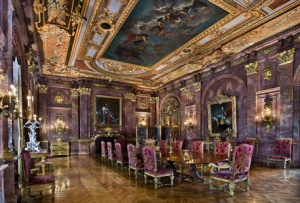
The Marble House, a Vanderbilt “cottage,” Newport, RI. Photo: Gavin Ashworth. Source: http://blog.newportmansions.org
Bottom line, I think Chypre Palatin is grandeur and sensuality on a scale that would have made Leonardo, half the Medicis, and all the bloody Borgias wet their pantalones. It’s been a months and months since I had such an immediate, intense reaction to a scent, such awed amazement, and a lemming turned into Moby Dick. (The last time was for Hard Leather, lest you’re curious.) I’m all in a tizzy, discombobulated, and hot under the collar. In fact, I better end this now before I spend a few thousand more words raving about Chypre Palatin and its baroque glory.




